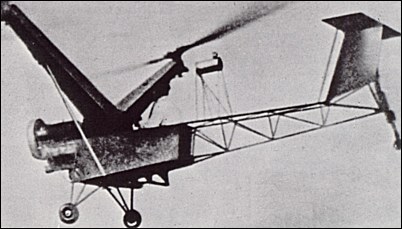|
|
Weir's chief designer, C.G.Pullin, first thought of converting the W.4 autogyro into a helicopter by using two co-axial rotors, but he finally adopted the system of rotors carried by outriggers on either side of the fuselage, like the 1937 record-breaking Focke 61.
The W.5 was a single-seater powered by an air-cooled engine; each of the two two-bladed rotors had cyclic and collective pitch control and they turned at 430 r.p.m.
This helicopter made its first flight at Dalrymple, Ayrshire, on 7th June 1938, when it was piloted by R.A.Pullin, son of the chief designer. By the outbreak of World War II it had logged eighty hours' flying time. P.Lambermont "Helicopters and Autogyros of the World", 1958
| Technical data for Weir W.5
Number of seats: 1,
engine: 1 x Weir rated 50hp,
rotor diameter: 4.57m,
gross weight: 381kg,
max. speed: 112km/h,
rate o climb: 122m/min
|
Warning: mysqli_connect(): php_network_getaddresses: getaddrinfo for mysql5.zone.ee failed: Name or service not known in /data03/virt15346/domeenid/www.aviastar.org/htdocs/helicopters_eng/weir_w5.php on line 71
Fatal error: Uncaught mysqli_sql_exception: php_network_getaddresses: getaddrinfo for mysql5.zone.ee failed: Name or service not known in /data03/virt15346/domeenid/www.aviastar.org/htdocs/helicopters_eng/weir_w5.php:71
Stack trace:
#0 /data03/virt15346/domeenid/www.aviastar.org/htdocs/helicopters_eng/weir_w5.php(71): mysqli_connect('mysql5.zone.ee', 'd14657sa18989', Object(SensitiveParameterValue))
#1 {main}
thrown in /data03/virt15346/domeenid/www.aviastar.org/htdocs/helicopters_eng/weir_w5.php on line 71
|





